May 1st, 2014 §
The overwintered ‘Red Russian’ kale has been a real treat this spring—sweet, tender and delicious. Unfortunately it’s already begun to bolt (go to seed), which means that the kale will gradually get tougher and more bitter as its energy goes into reproduction.
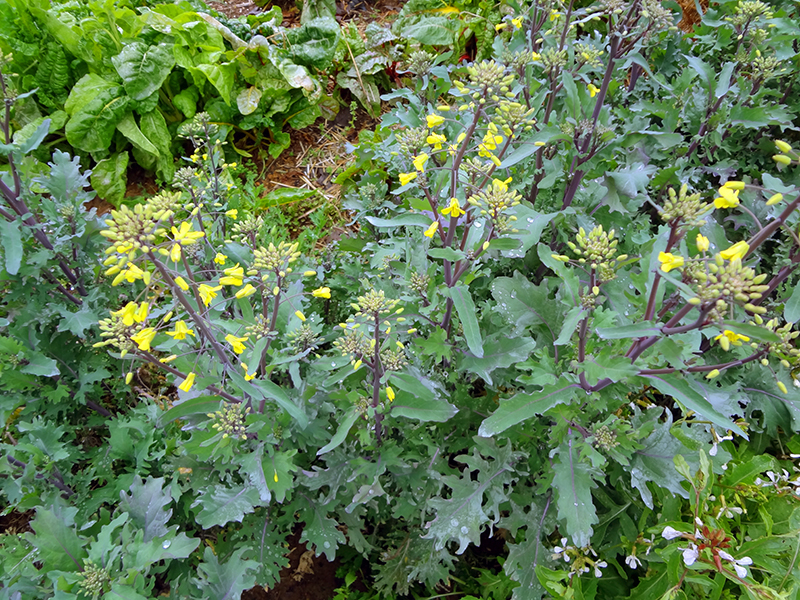
I’ve been harvesting kale almost every day, and the other night I cut off the flower heads to try to slow the bolting process. I nibbled on some of the flower heads and found them delicious. Further down the stem was edible and tasty as well, with a texture like very thin asparagus.
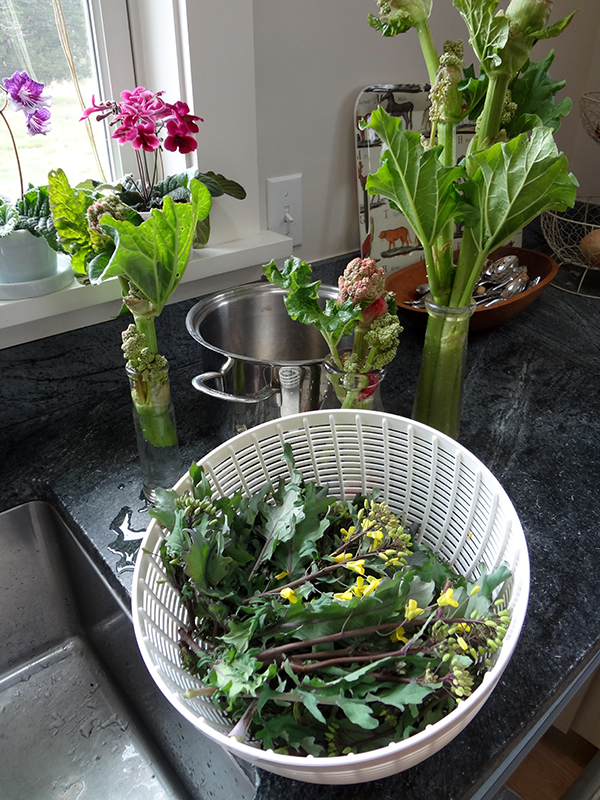
I washed the flowering heads and gave them a rough chop. They went into a saute pan with olive oil, a clove of chopped garlic, and a few golden raisins. A few seconds on high heat cooked them to perfection, just wilted through but still vibrant, healthful green.
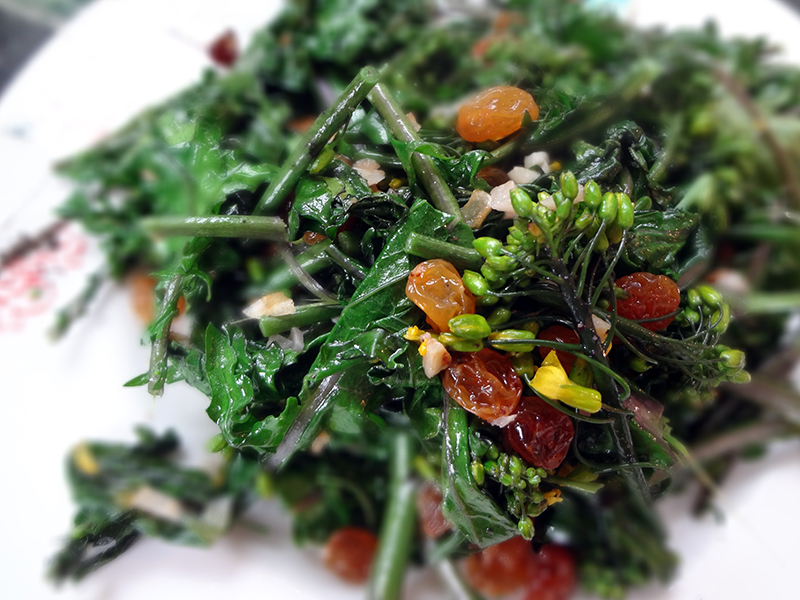
I’m pretty sure that as the season goes on these flowering heads won’t be nearly as delicious, but if you can catch them in these first days of spring you’ll enjoy an unusual treat.
April 29th, 2014 §
I was away from the farm for 16 days in April, and when I returned last week it was to a different world than I’d left. I completely missed the flowering of the earliest ornamental trees, the cherries and crabapples, but the dogwoods are in full bloom. The spring continues the cool and damp weather pattern of the winter, which is actually nice as the low temperatures keep the blooms around much longer than they do during springs that shoot right to 85 degrees and stay there.
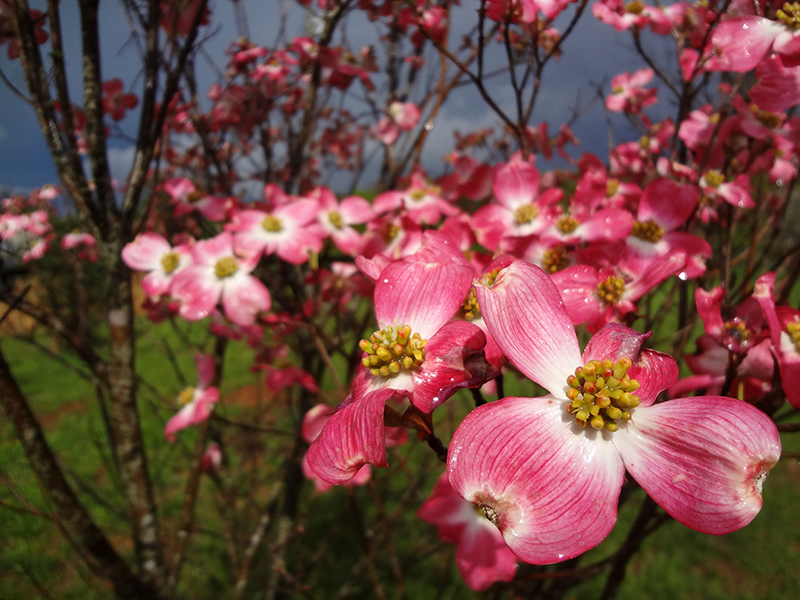 Dogwood ‘Cherokee Brave’
Dogwood ‘Cherokee Brave’
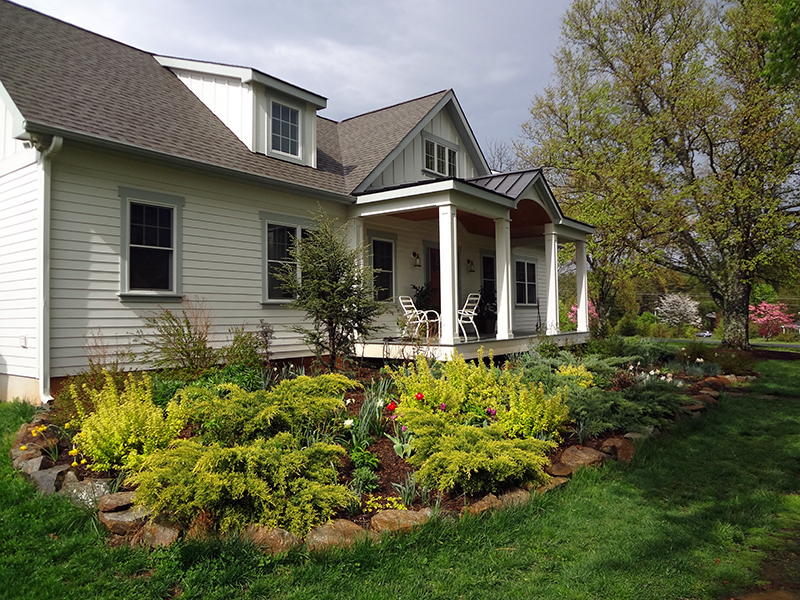
 Leucojum aestivum ‘Gravetye Giant’
Leucojum aestivum ‘Gravetye Giant’
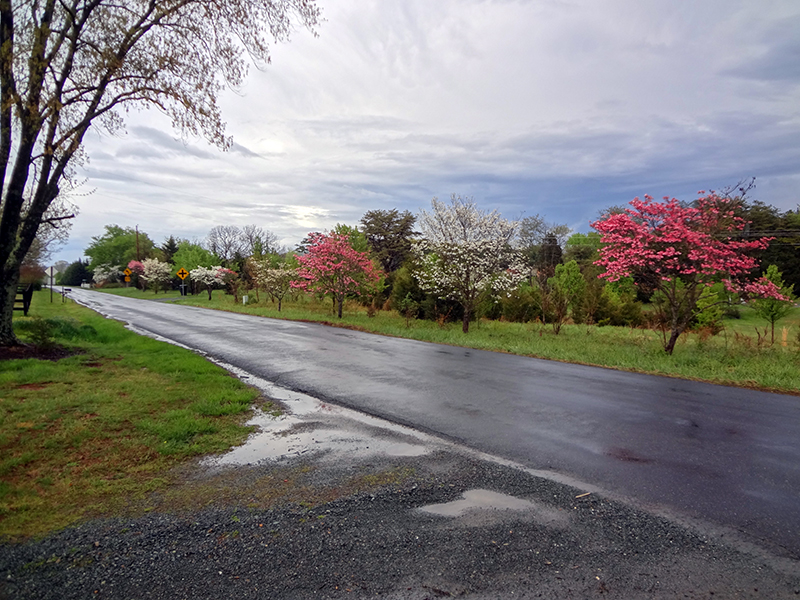
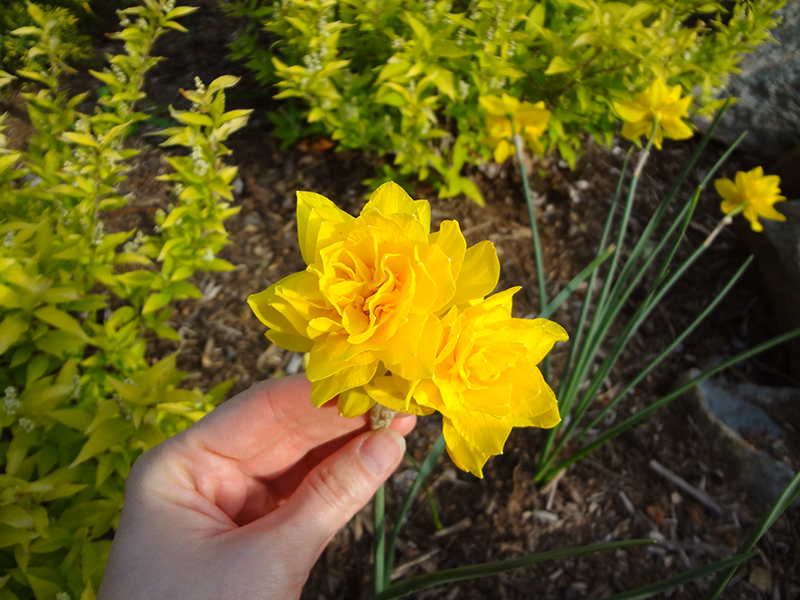 Narcissus ‘Rip van Winkle’
Narcissus ‘Rip van Winkle’
 Magnolia ‘Jane’ (right behind Tuck)
Magnolia ‘Jane’ (right behind Tuck)
 Homestead lilac
Homestead lilac
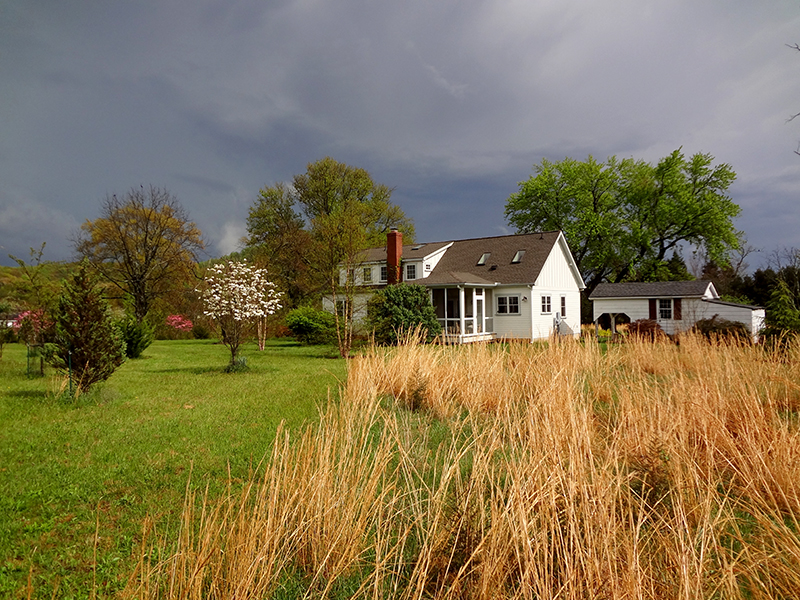
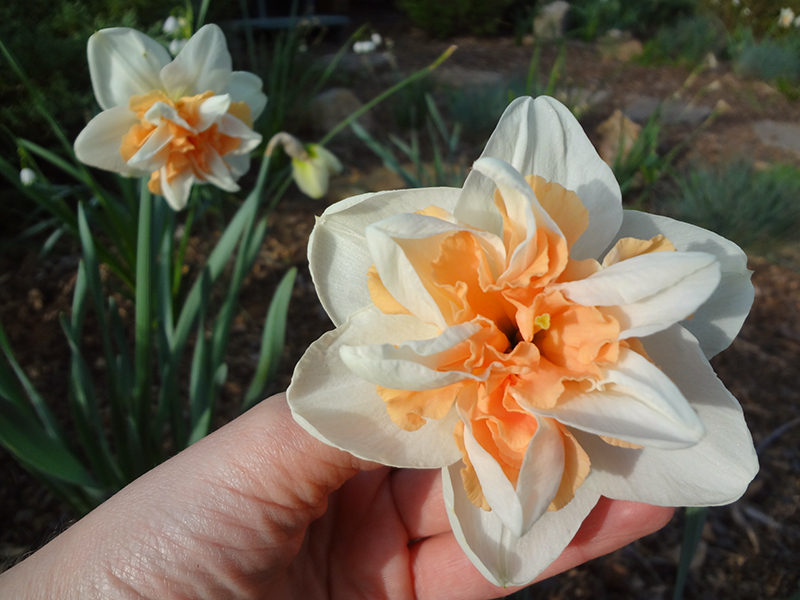
Narcissus ‘Delnashaugh’ is definitely my favorite of the bulbs added last fall—a wonderful coral/apricot color and huge blooms. Daffodils are up there in my top three flowers—my dream is to have great fields full of naturalized drifts, and then a whole other specimen collection for up-close appreciation. The bulbs I added to the front garden last fall are a good start toward this plan.
After such a long, cold, and snowy winter, I am especially appreciative of these spring blooms. I am not, however, especially looking forward to grass-mowing season, which is already underway!
March 24th, 2014 §
Last fall I had grand ideas of building a cold frame to overwinter spinach, kale, chard, and salad greens. In late October, right before the first frost, I stuffed 18 strawbales in the bed of the pickup and when I got home used them to build a small fortress around some rows of greens that I’d sowed earlier in the fall.
 October 22, 2013
October 22, 2013
I made a one-and-a-half-story, south-facing design thinking that the angle would help trap the sun’s heat and shed water off the big sheet of contractor’s plastic that I draped over the top for a lid. I secured the plastic on top of the bales with some scrap lumber, bricks, and cinder blocks. It was admittedly a hot mess to look at, but that’s one reason that I hid the veg garden out of sight from the house and road!
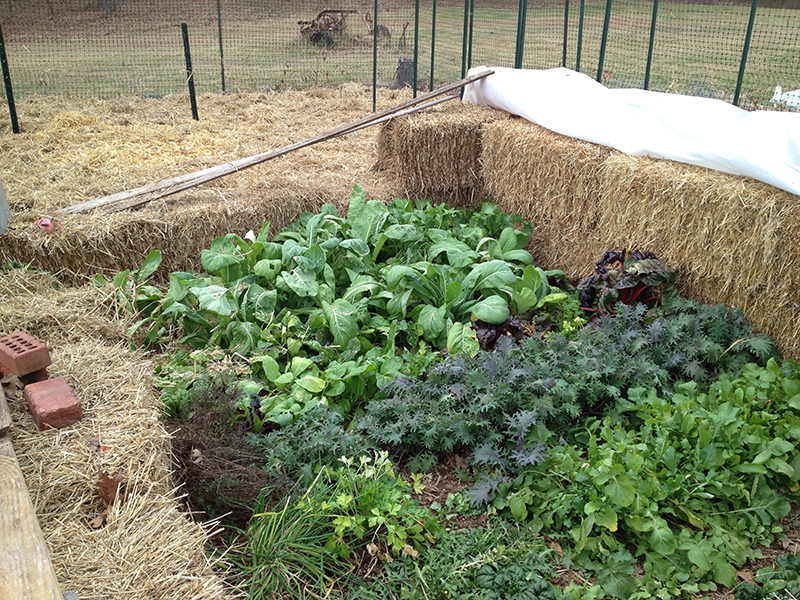 December 5, 2013
December 5, 2013
Things looked good into December, and I kept harvesting greens. But then it started to get really cold and going out to the garden to wrestle with frozen plastic and the icebergs caught in its folds didn’t appeal. So I abandoned the cold frame to the savages of this very long, cold, and snowy winter.
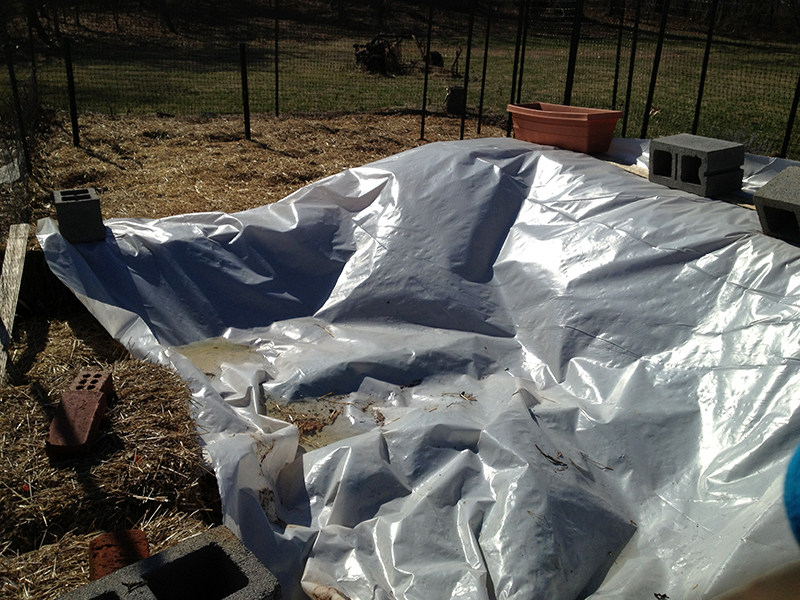
Today I thought I would peek under the plastic, and I was surprised to find quite a few plants happily growing. There were vigorous-looking weeds starting to set seed, though outside the protection of the cold frame none of these weeds are growing yet anywhere on the property—proof that I was successful at creating a little warm microclimate! I was pleased to see chicory, which is called a weed but is actually a very healthy edible spring tonic that you can add to your salad. The Red Russian kale looked pretty good, as did the spinach, and the arugula was flowering. The chard and mustard didn’t make it through as well.
 March 24, 2014
March 24, 2014
This is a happy discovery as these little plants, which have existed in suspended animation over the winter, mean a jump on the spring growing season—saving weeks of waiting for spring-sown seed to germinate in cold soil. These plants are undoubtedly strong beneath the surface, and all they will need to get up and growing is some more heat and water. After we get through this week—with more cold temps and even possible snow tomorrow—I will start opening the top of the cold frame for short spells to get the plants used to the temperatures and sun.
When it comes time to plant the whole garden, I will spread the nicely aged straw in these bales around the garden as part of my deep mulching soil-conditioning and weed-suppressing strategy.
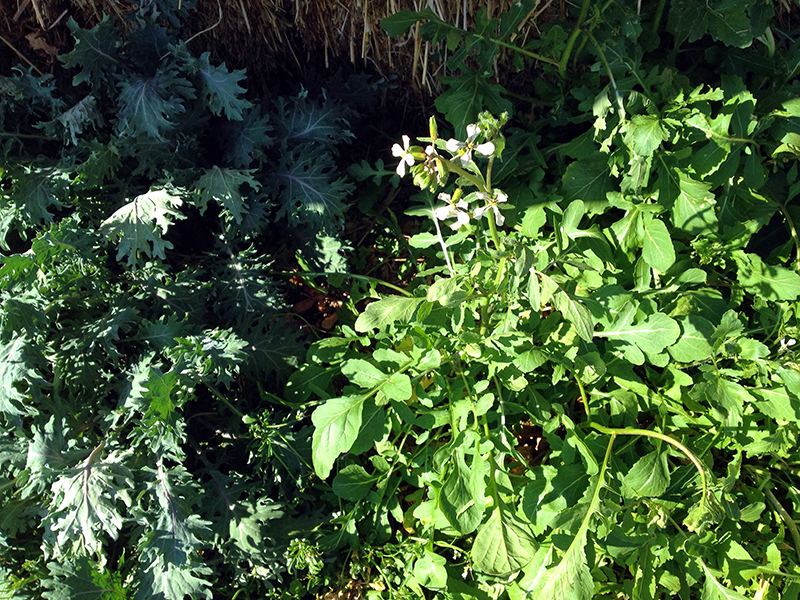
I will still probably sow some more greens from seed, just to experiment, but while I wait I will be enjoying winter-sweetened greens that amazingly hung in there through multiple polar vortices, being flattened under 16″ of snow, and everything else this winter threw at them.
I am pretty happy that what I thought was a failed experiment at getting greens to grow all winter actually isn’t a total failure. I maybe wasn’t eating lush garden-grown salad in the deepest part of winter, but I can right now, and I probably could have weeks ago had I just peeked under the plastic!
March 11th, 2014 §
I stepped outside yesterday to see these tiny Iris reticulata had bloomed overnight. It’s amazing what a shock to the eyes a three-inch tall purple plant can be after acclimating to a winter’s color palette of brown, gold and grey.

Even more interesting is that these iris are blooming within days of when they bloomed last year, which I find fascinating because last winter was abnormally warm and this winter has been record-breakingly cold. I would have expected the flowering bulbs to be a bit delayed, but I guess once those longer daylight hours hit there’s no holding them back, whatever the weather.
I am very excited for this spring in the garden. I did a lot of work last spring and summer adding new perennials and moving things around, and last fall I planted a bunch of exciting new bulbs. It’s going to be fun to see how this all comes together this year.

The daffodil and iris planted in the woods are also emerging from their warm blankets of fall leaves. I am really curious to see if the iris actually flower. They’re all from the truckful that my friend Todd donated to the farm last spring. I had way too many to plant around the house so they went rogue and joined the woodland garden.
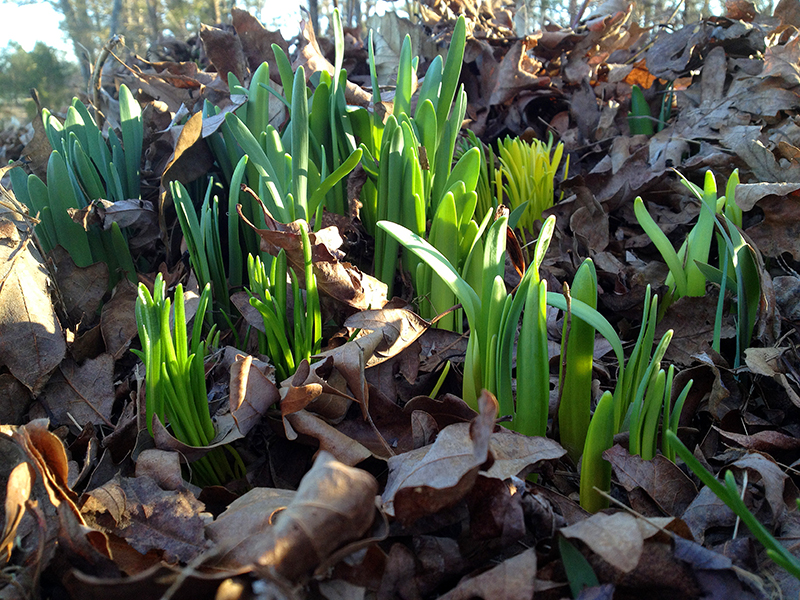
And tonight I heard the first spring peepers of the year! That is definitely the sound of spring,
March 8th, 2014 §
The most gardening I’ve done in months. Playing in the dirt, even sterile potting mix, feels. so. good.
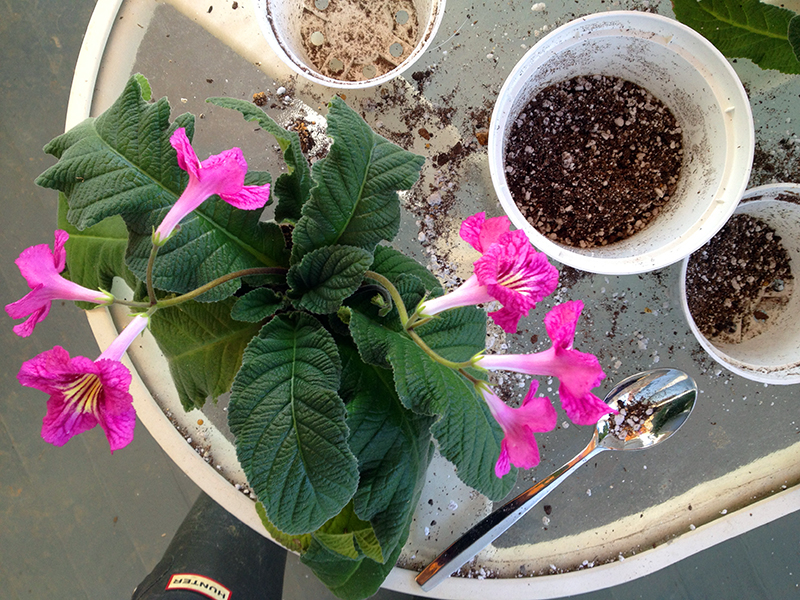
February 17th, 2014 §
I just came across this collection of photographs from a contest sponsored by the Royal Botanic Gardens, Kew, in England, and I have been mesmerized for a long time, taking in the details of each exquisite photo. I don’t reblog much, but these images are on par with anything I’ve seen come out of the National Geographic Photo Contest and deserve as much exposure as they can get. Maybe I’ll submit one of my own images to this contest some day—seeing these photos is real motivation to keep upping my own photographic game.
It’s easy to piece together some trends from this winning collection. Of course the New Perennials are still going strong, as evidenced by the contest winner, Rosanna Castrini, an Italian garden designer who describes her gorgeous garden as a prairie. Her photo, below, has reawakened my lust for Echinachea “Magnus,” a magenta coneflower (and 1998 Perennial Plant of the Year) that’s been on my radar for a few years but I’ve yet to encounter in any local garden center. Also still hot are representations, either natural or planted, of “meadows.”
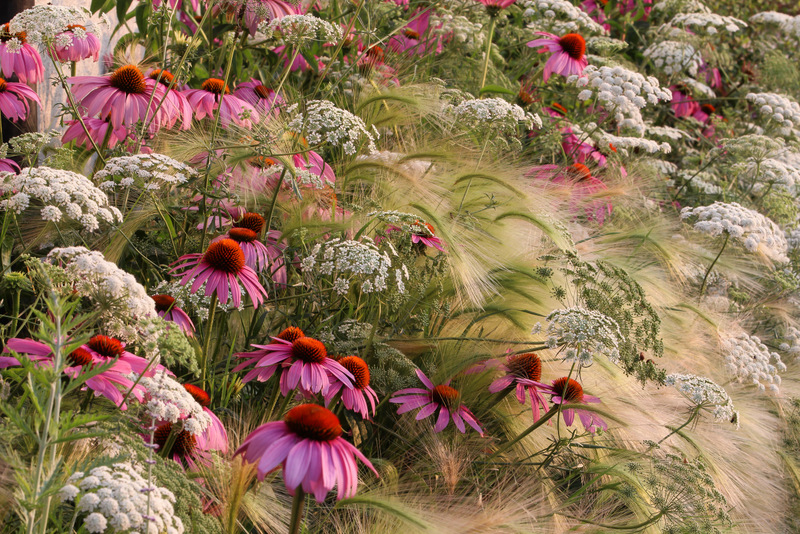
Take some time to click through and enlarge each of these images. At the very least you’ll find a break from the seemingly relentless cold and snow surrounding most of us. And at best, you’ll take away some inspiration for a future garden design.
February 14th, 2014 §
Around six tonight I suddenly remembered it was the eve of February’s full moon. I ran outside with my camera and tripod to get a few shots as it rose in the front yard over Buck Mountain. The moon’s light on all the snow made it so bright that within a few minutes of my eyes adjusting I could have walked anywhere I wished without any extra light.
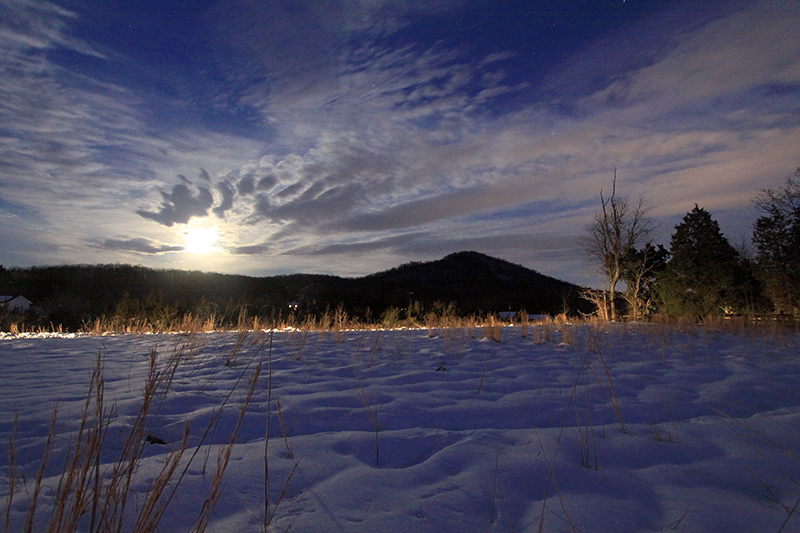
A far-away friend recently asked me if you could see any stars from my farm. Well, here’s your answer. Even on a full-moon night, the stars pop out of the sky.
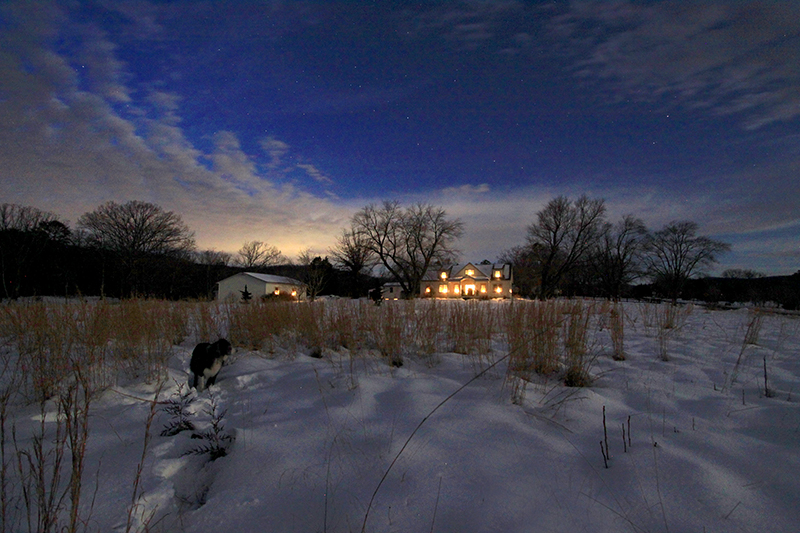
It’s nights like these that I’m again reminded why I like to leave the hay standing in the front field over winter, instead of bush hogging as most people do in fall. Not only does it create lots of habitat—the place is riddled with deer beds, and Tucker is constantly hunting voles and rabbits out here—it also makes a more interesting picture. And, I love the golden color of the standing grass. In the grey darkness of winter, I will take color anywhere I can get it.
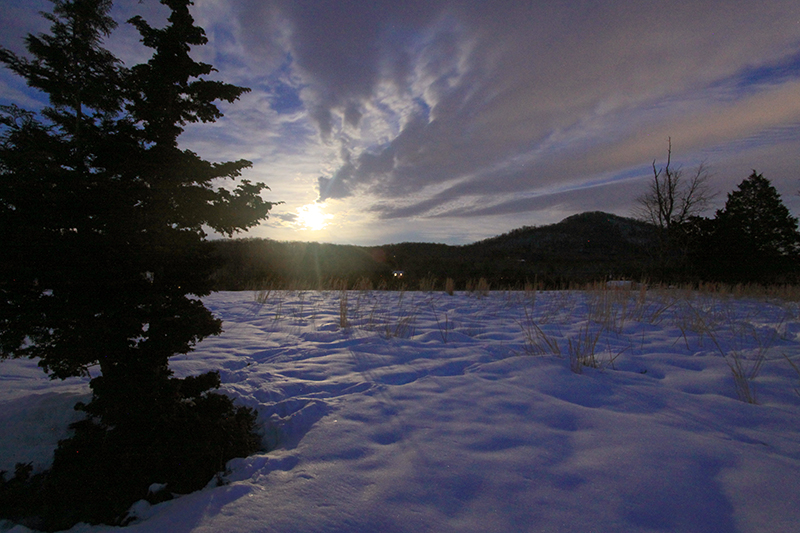
Full moon with Chamaecyparis obtusa, in foreground, and Juniperus virginiana, at far right. Cultivated and wild, planted by me and sown by birds, respectively.
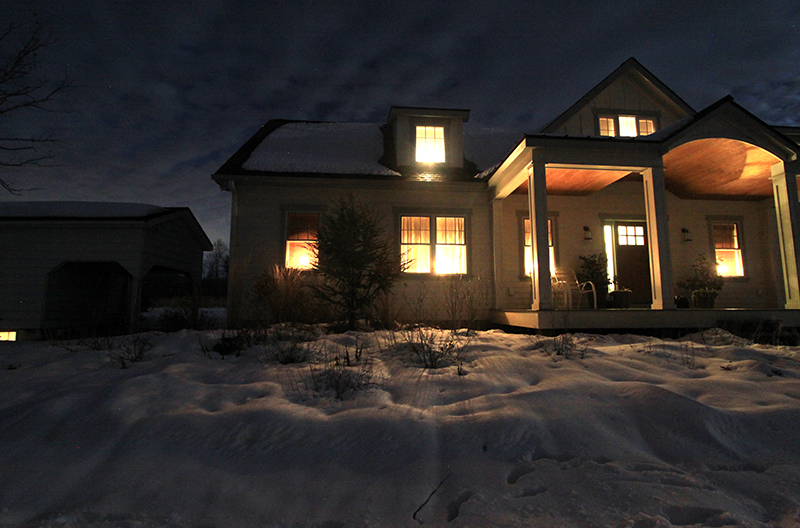
Winter garden, under 15″ of snow. I am loving the architecture of the rock wall beneath the snow, and how something so low and jagged has been smoothed into great pillows lining the bed.
There’s another little clipper system on the way, and even in the fifteen or so minutes I was out taking photos the clouds started to thicken and obscure the full moon. We’re supposed to pick up another inch or so of snow overnight, but next week temps are forecast to be in the 60s. Undoubtedly all the daffodils will be tricked into thinking it’s spring, only to be dumped on by the snow that always falls into March.
January 22nd, 2014 §
Snowplows are rumbling outside my window, the white stuff’s still coming down, and temps are cold enough to warrant a red-light district in the chicken coop. Sounds like a great time to revisit England in July, this time to the Royal Botanic Gardens, Kew—a must-see spot on any gardener’s tour of England.
Kew was founded in 1759 and declared a UNESCO World Heritage Site in 2003. I thought that seemed pretty old until I looked up the world’s oldest botanical garden, which is in Padua, Italy and was created in 1545. The Padua garden is also a World Heritage Site, according the UNESCO, “considering that the Botanical Garden of Padua is the original of all botanical gardens throughout the world, and represents the birth of science, of scientific exchanges, and understanding of the relationship between nature and culture. It has made a profound contribution to the development of many modern scientific disciplines, notably botany, medicine, chemistry, ecology, and pharmacy.” Most people don’t immediately think of all these far-reaching implications of gardening, but there you have it, and it’s all true.
But that’s enough trivia—we came here to see Kew, and Padua will just have to join the very long list of gardens yet to be visited. In addition to being a top London tourist attraction, Kew is also a research institution for plant science and conservation. I can’t speak to any sort of research that’s happening at Kew, and can only appreciate it as a gardener. It’s definitely impressive, and huge, and though I’ve visited it twice on separate trips to England, I am sure there is still more to see. Far be it from me to cover it all in a couple of posts, so I will just focus on the areas most interesting to me.
In addition to giant, Victorian-era glasshouses that house palms and tropicals, there are a few more modern structures:

The structure above, to the left, is the newest glasshouse and one of my favorites. It’s the Davies Apline House, a rock garden full of all sorts of tiny little plants—most of them seeming Mediterranean in origin. I love how these small plants are basically served up on rocky platters, brought close for use to appreciate them in detail and in pleasing contrast to their rocky ledges. Can you believe that four full-time staff and one trainee are dedicated to the care of this glasshouse, which isn’t much larger than what you see in the photo? That is wonderful to me—so many talents and resources dedicated to such tiny plants in a little space.
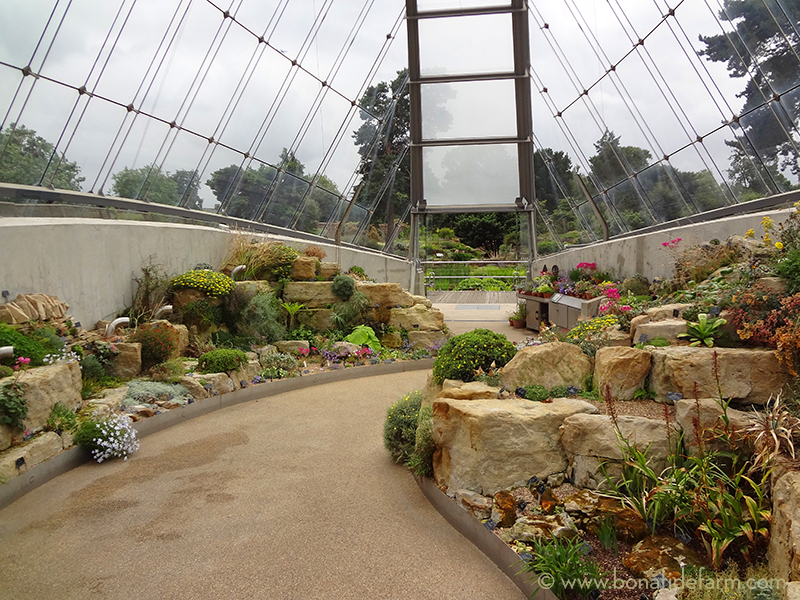
It was in this display that I found a spectacular oregano, Origanum amanum, from Turkey. It’s similar to a hybrid ornamental I grow in my own garden, Origanum “Kent Beauty.” The blue flower in the photo is some sort of bell flower.
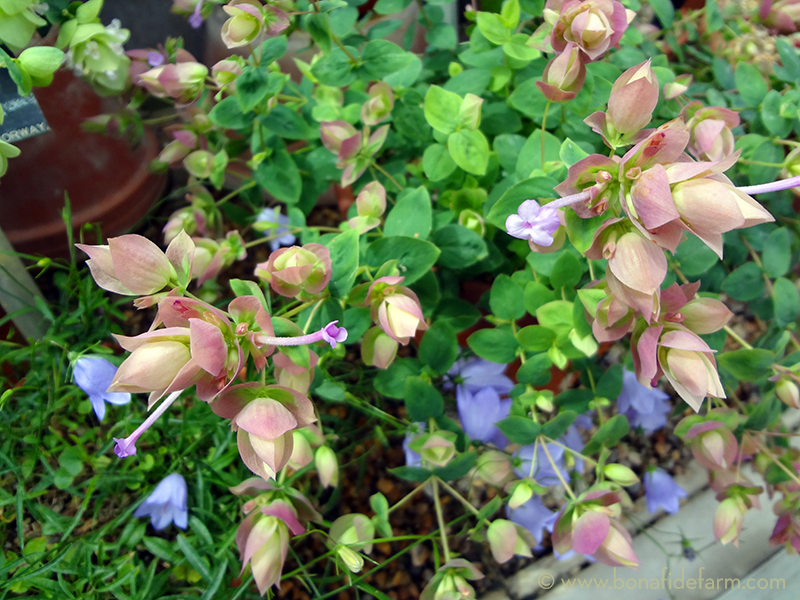
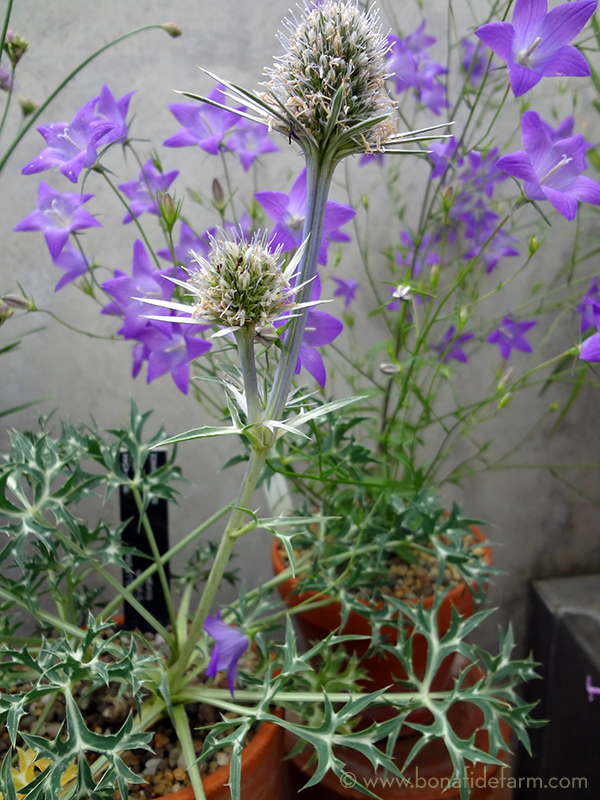
Just outside this glasshouse is an outdoor rock garden, which is one of my favorite areas of Kew. What I like about it, again, is how the rocks form a stage that elevate into the spotlight small and perhaps easily overlooked plants.
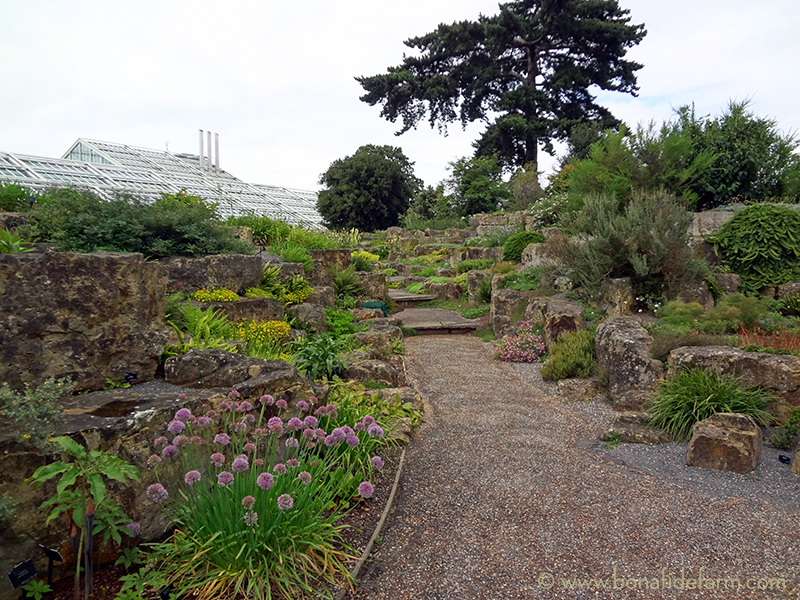
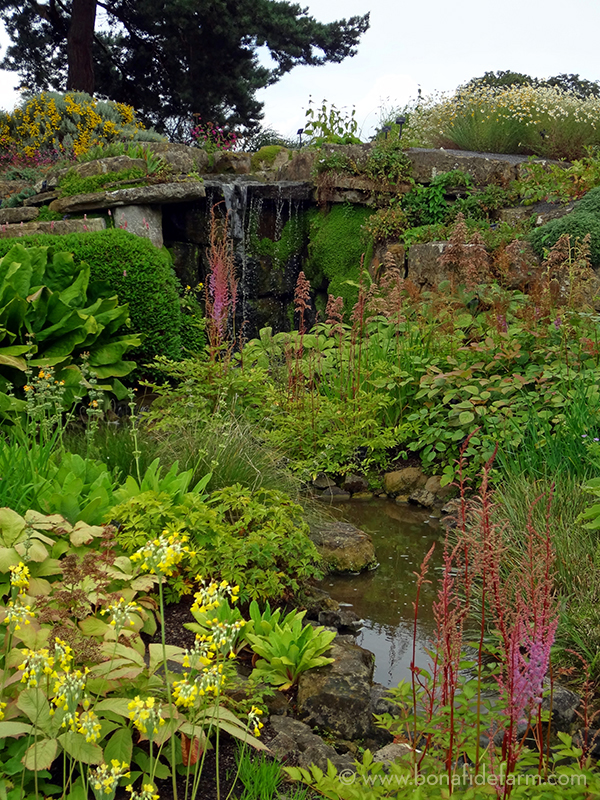
Near this area is a series of great meadows planted with all sorts of grasses. I love the painterly effect of their intermingling, and that they would be relatively low maintenance. This is definitely an idea I’d like to try somewhere on my own property—once I can get past the on-the-surface foolishness of replacing a perfectly good natural meadow with a cultivated one!
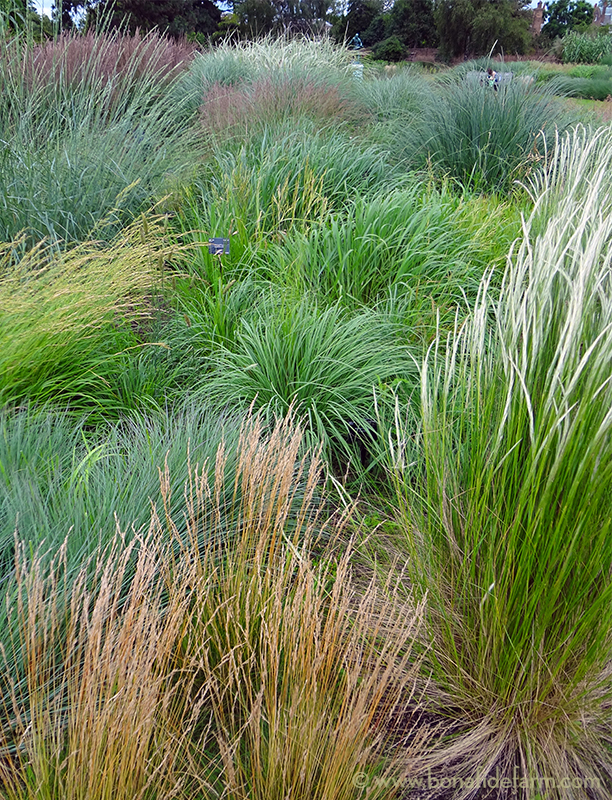
I won’t focus too much on the glasshouses, as I found them to be the least interesting part of Kew. They’re neat in that they’re old, and have lots of peeling-white-paint patina, but the plantings inside them just weren’t as interesting to me as what was going on outside. Perhaps that’s because I approach every garden visit with an eye toward what I can appropriate for Bonafide Farm, and a greenhouse full of tropicals just isn’t in my future. Although, funnily enough, my neighbors opened a winery centered on a giant greenhouse full of tropicals, so it’s certainly possible right in this mountainous little valley in Central Virginia.
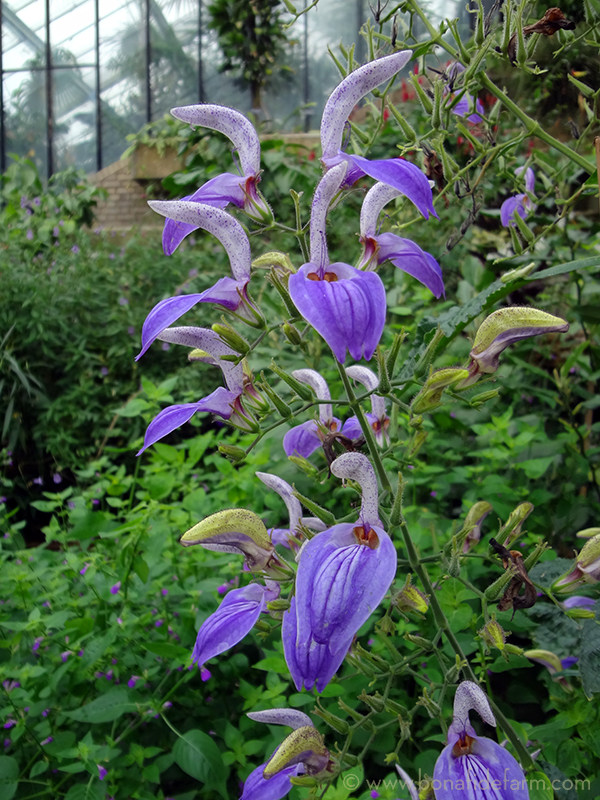
I couldn’t resist, however, this flowering vine growing in one of the glasshouses. I know not what it is, but isn’t it exquisite? If you can i.d. it, tell me in the comments, please!
Up next in part two, walking the grounds of Kew, and getting some wood with the sculptor David Nash.
January 19th, 2014 §
“Gardening” is a bit of a stretch for what I did today as I walked the property, but it’s all I can do. With everything cold and sleeping, today’s tasks included checking staked trees for girdling and rodent attacks. I scraped a liquified but frozen dead mouse (mousesicle?) out of the crawlspace entry, and pruned still-more cicada damage out of the dogwoods. Most of my time was spent shoveling and sweeping the house garden’s mulch and compost back into place. The chickens are doing their winter thing, which is scratching in the loosest, most fertile and worm-filled soil of the acres they have access to—which happens to be in my garden. Of course. All this chicken activity exposes the prenatal tips of spring flowering bulbs, all pale and startled-looking to be so untimely unearthed.

So I go around and cover these little tips with compost and try to move and pat everything into place with reassurances: “Not quite yet, naked ladies, hold tight for a few more months and if any of those chickens take a nip, bite back.” Even as I tuck these shoots away it’s hard to contain my excitement that something’s happening under the dirt. Those promises sowed in November are halfway toward realization.
I’m itching to take the pruners to some of the standing dead perennial foliage that’s dragging the ground, but I learned my lesson last year when I lost track of where I’d planted certain things and smothered them under a new mulch application. So the stragglers stand, marking the location of my plants at least until I get the spring mulch down. I’m trying to view these dried-out sticks and seed heads through the naturalistic lens of some of my favorite garden designers, who design entire landscapes to be appreciated just like this in winter.
The best-looking thing in the garden right now is almost microscopic: my sedum. Sedum “Angelina” has taken on fantastic rainbow colors, and some unnamed small pink sedum is positively fluorescent.

It looks like the polar vortex of a couple weeks ago has already claimed some casualties. My Distylium “Blue Cascade,” which is being heavily marketed as an evergreen landscaping shrub suitable for zones 6b-9, is showing an aesthetically distressing but intellectually interesting pattern of winter burn that wasn’t there before we had our flirtation with zero degrees.
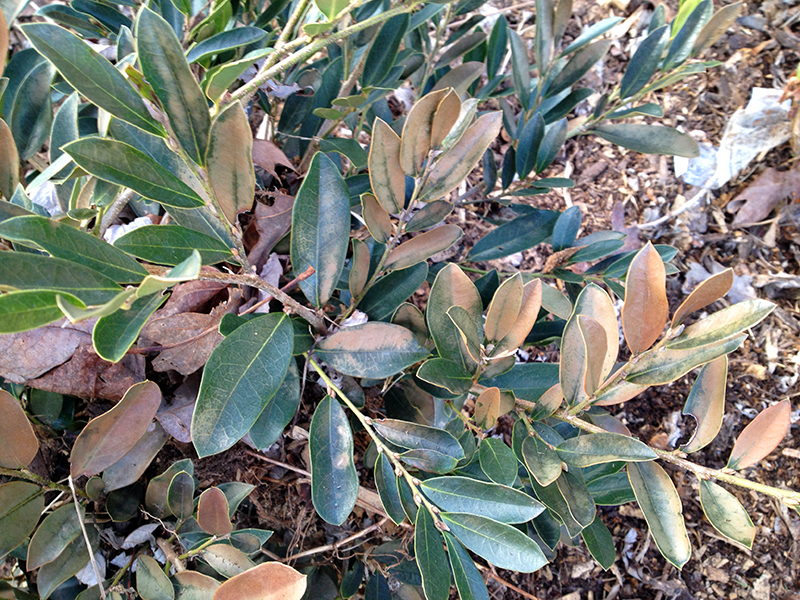
It will be interesting to see how it recovers—good thing I stuck just two of these shrubs in to trial instead of relying on them to carry an entire foundation planting.
And one of my two large clumps of rosemary decided that zero degrees just isn’t a Mediterranean climate, and it’s begun to brown out in a serious way.
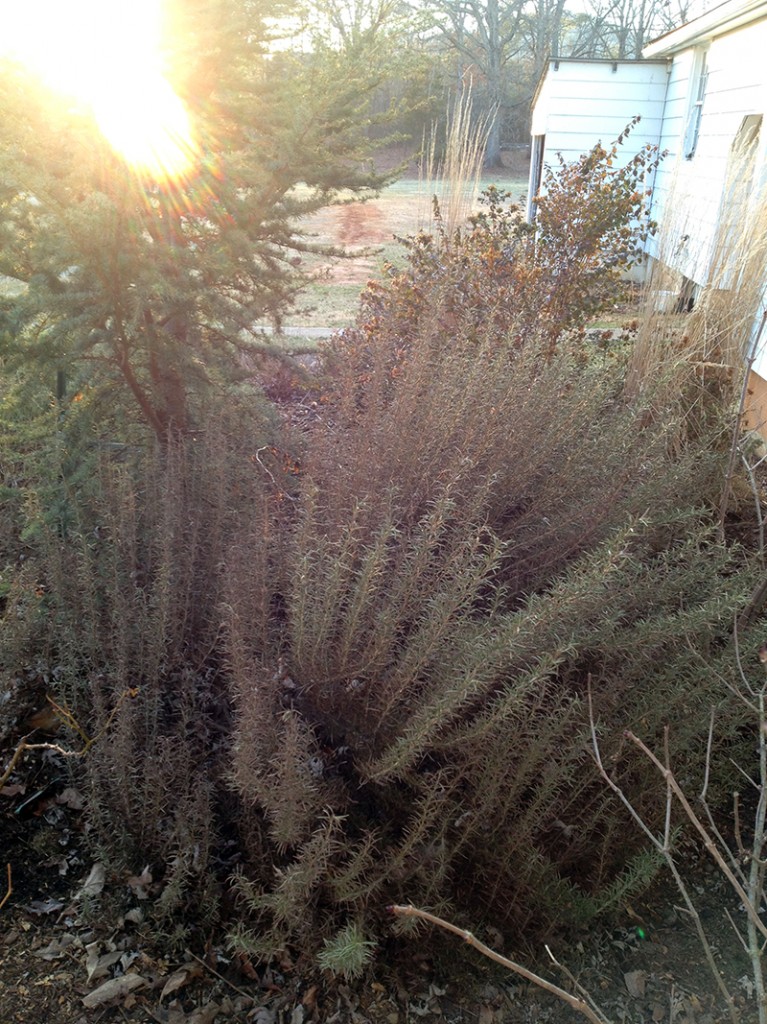
I admit that this big clump, which began as three smaller plants, wasn’t in peak form heading into winter. It had some sort of mite infestation that, while it wasn’t killing it, wasn’t exactly helping things. The interesting thing is that the other rosemary grouping, less than 20 feet away on the other side of the front walk with a similar exposure, evaded both the mite problem and the damaging effects of the polar vortex. Just like humans, plants with healthy immune systems are better able to withstand environmental stressors.
Is it sick to be excited to rip out the rosemary and have a nice big section to fill with something new? I didn’t ever plan for rosemary to become a foundation planting for me—I wasn’t expecting it to be winter hardy here—but it was (for a while!) and once it got big and took up space and stayed greenish through winter, I let it live. But now that it’s brownish, I have no compunction about pulling it all out come spring. As I’ve said before, I like taking things out of the garden more than I like putting things in. It’s a great feeling to give myself permission to correct course midstream, experiment, modify and adapt, and put new knowledge into practice through good editing.
January 15th, 2014 §
We continue our tour of Bourton House by focusing on a few details. The image below is a good representation of what I just learned from Ursula Buchnan, in The English Garden, is the quintessential English garden: “informal and generous planting within a formal layout.” Such a simple definition but it cracked open a world of understanding for me. You can see the formal elements in the lawn bounded by paving blocks and in the wall at the far end of the path. But the plantings within this structure are riotous—they range and blend together and overspill their bounds onto the lawn.
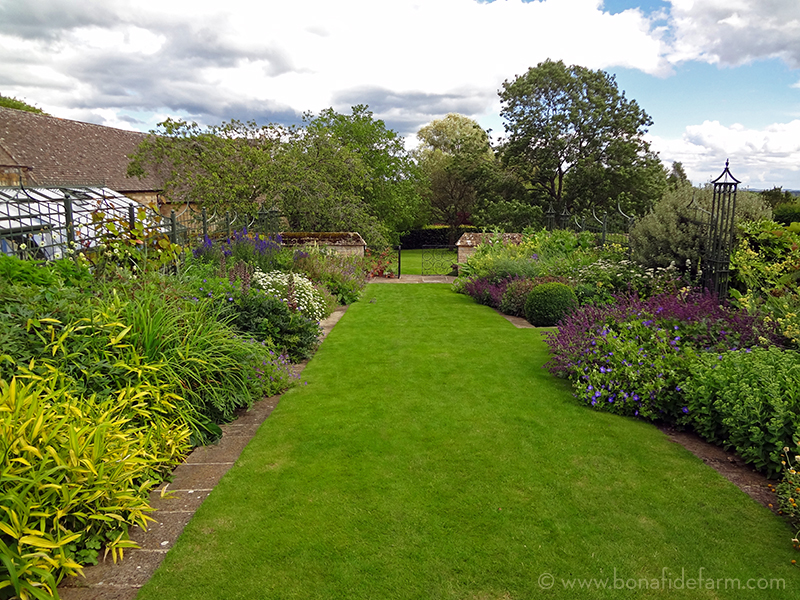
Even though they don’t fit the “English garden” definition as well as the photo above, I loved the areas in the two following photos. The collection of succulents and specimen plants looks like something I do at my own house, when all my tender plants go outside to spend the summer on the porch of the well house. I loved the succulents growing out of the wall, below, which gave the effect of the plants on the ground literally climbing the walls.
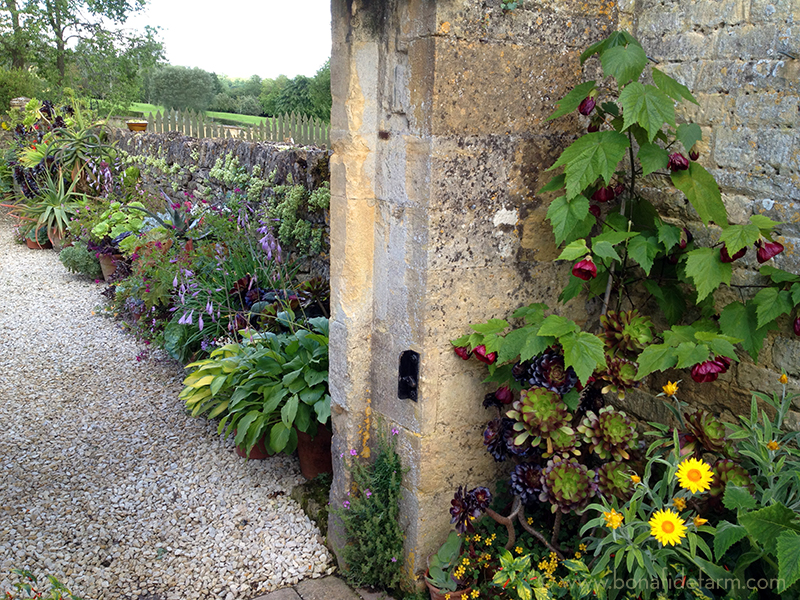
Someone with a great eye for color put this tiny masterpiece together. The shape of the geranium leaves (far right) really plays off the shape of the green and pink succulent in the center and makes for a unexpected and fascinating pairing.
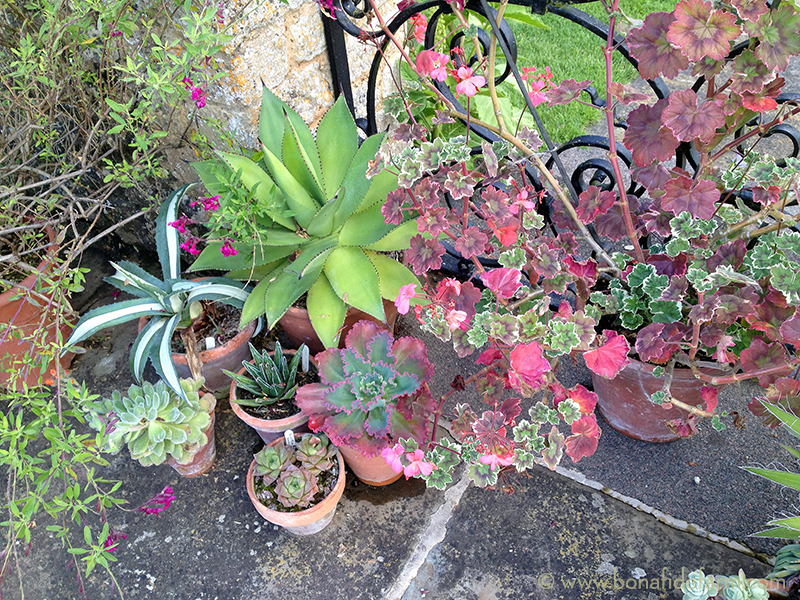
Next up, one of the coolest structures I’ve visited in England, the tithe barn adjoining Bourton House. It has a dedication stone of 1570 with the initials RP for the then owner, Richard Palmer. Back in the Middle Ages it was used to store the one-tenth of the farm’s produce that was tithed to the Church. What I loved about this space, which is now used as a gift shop and event space, was the proportions of the huge interior and the way the yellow Cotswold stone block walls joined to the plaster and beam ceiling. And look at these cross beams! They’re some seriously wonky, wormy, incredibly beautiful old wood.

The detail on the balcony railing was also particularly nice, with the wavy balusters. The finials were my favorite—hand-carved and crooked in a wonderful way that made them appear full of personality.
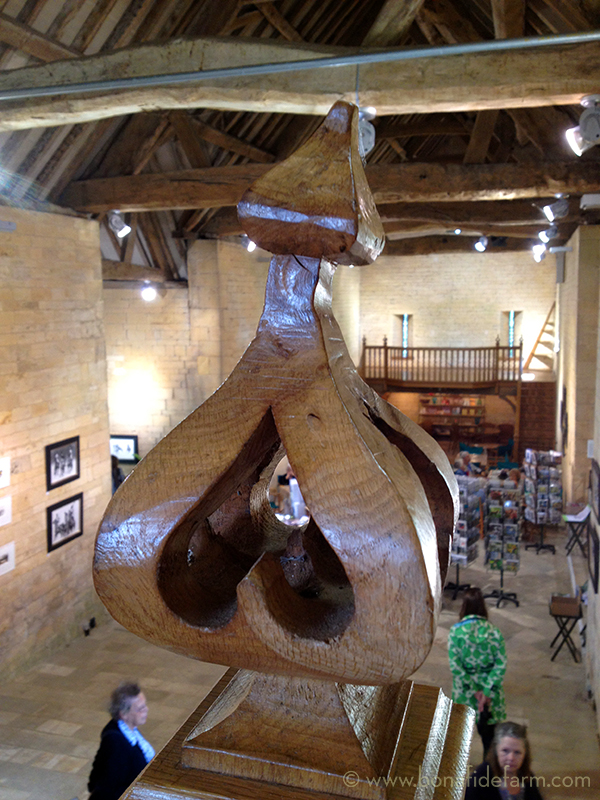
Back outside, I found the only topiary I’ve ever liked:
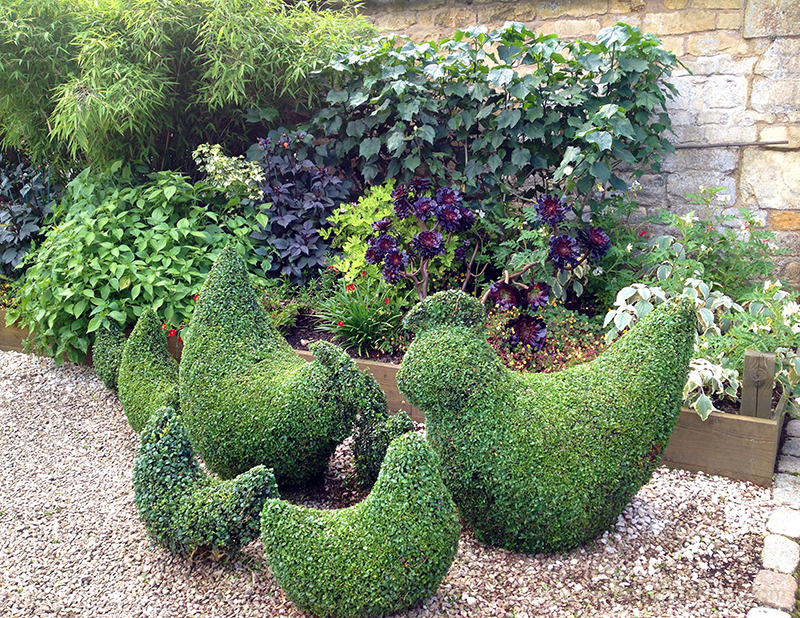
And finally, the mixed shrubbery planted along the exterior of the Bourton House fence is another master class in combining foliage colors.
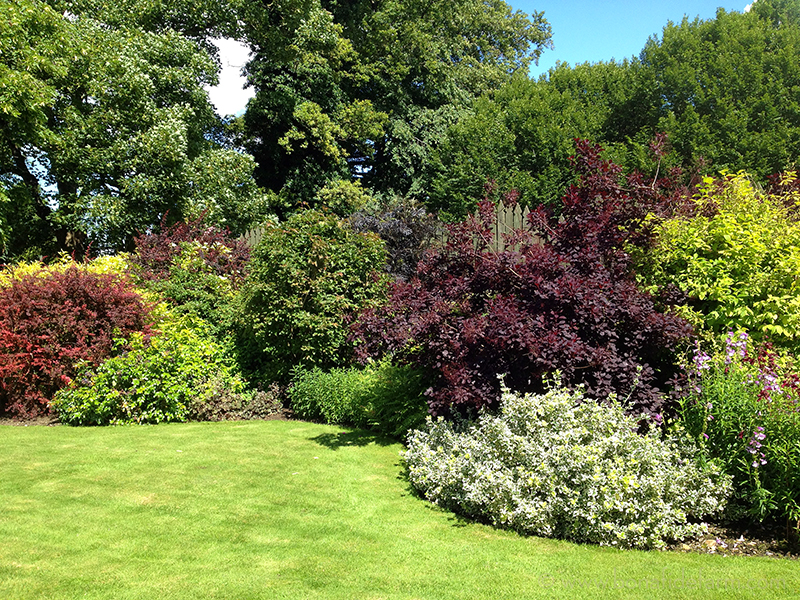
Some day, something like this is what I’ll do in the field between my house and my neighbors, in front of the screening trees that I planted a few years ago. At least this is the vision!













































